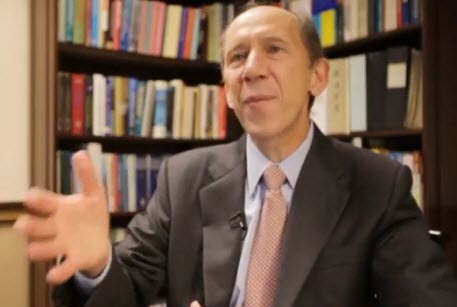There are countless books laying out the case for index investing, but as far as I know there has never been a film—until now. A UK investment firm has just released a 54-minute documentary called Passive Investing: The Evidence, which includes cameos from some of the leading proponents of strategy.
The film was financed by Barnett Ravenscroft Wealth Management, which manages portfolios using products from Dimensional Fund Advisors and Vanguard, so they clearly have a vested interest in promoting the strategy, but it would be unfair to dismiss the film as an hour-long infomercial. BRWM works only with individuals and institutions who have over £1 million in investable assets, yet the company seems eager to get its message out to the UK public, even though the vast majority of the film’s audience will never become clients.
They’ve certainly made a significant investment in the film: the production quality is very high and the interviews include luminaries such as John Bogle, Charles Ellis, Rick Ferri, Kenneth French, William Bernstein, Burton Malkiel and William Sharpe. Not since Toy Story have so many potatoes appeared in one film.
A shaky foundation
The documentary is divided into eight chapters. The first two do a good job of covering ground familiar to Couch Potatoes: the failure of most active funds to outperform and the erosion caused by high costs. Part 3 lays some theoretical groundwork, including the Capital Asset Pricing Model (CAPM) and the Efficient Markets Hypothesis. I appreciate the challenges of bringing these complex ideas to the public, but I found this chapter problematic. CAPM—which predicts the expected return of a security based on its beta—is still widely taught, but it doesn’t do a particularly good job of explaining returns in the real world. (The Fama-French three-factor model is a dramatic improvement.) So I’m surprised the film’s website describes CAPM as “the mathematical foundation of passive investing.”
It’s also going too far to suggest that in an efficient market “shares are always priced correctly because they already reflect everything that is publicly known about the company.” I’m not sure anyone believes stocks are “always priced correctly.” The more subtle argument is that inefficiencies in the market certainly exist, but they are short-lived and extremely difficult to exploit in any systematic way.
Why isn’t passive more popular?
 Part 6 is an interesting look at why active strategies remain so popular, despite the evidence that most of them fail. Here the film hits all the right notes, explaining that it’s a combination of powerful marketing by investment firms, distractions in the financial media, and behavioral biases such as overconfidence. The best quote comes from Ken French when discussing the constant need for newspapers and magazines to celebrate hot fund managers: “Put me on the cover and you’re not selling anything.”
Part 6 is an interesting look at why active strategies remain so popular, despite the evidence that most of them fail. Here the film hits all the right notes, explaining that it’s a combination of powerful marketing by investment firms, distractions in the financial media, and behavioral biases such as overconfidence. The best quote comes from Ken French when discussing the constant need for newspapers and magazines to celebrate hot fund managers: “Put me on the cover and you’re not selling anything.”
In Part 7, the film argues that passive strategies are gaining a foothold in the UK, where they currently make up only 7% of retail investor assets, compared with about 30% of institutional assets. (I’d estimate the popularity of indexing is similar in Canada, though it’s about twice as high in the US.) The discussion touches on the arrival of Vanguard in the UK in 2009: “Vanguard believes that passive investing has far greater potential in the UK because the cost of active fund management is higher over here than it is in the US.” Of course, those costs are even higher in Canada, so Vanguard must have seen enormous potential when it landed here in 2011. Unfortunately, a lot of that potential remains untapped.
If you’ve got a friend or relative who’s interested in the Couch Potato strategy but not inclined to read a whole book about it, send them a link to this short film, which is also available via YouTube. It might be the best 54-minute investment they’ll make this year.

